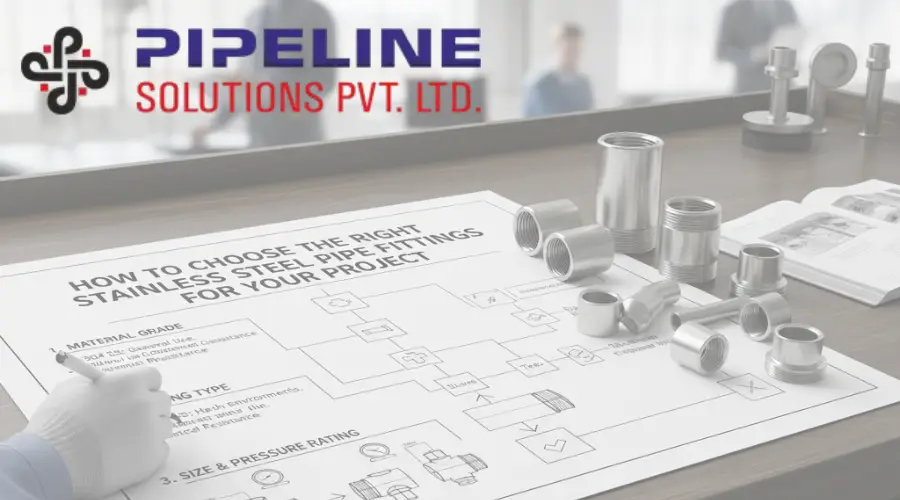
Selecting the right stainless steel pipe fittings for your project can feel like navigating a maze of options, especially if you're not a seasoned engineer or plumber. With so many grades, sizes, and types available, it's easy to make a costly mistake that leads to leaks, corrosion, or system failures. But don't worry stainless steel pipe fittings are a reliable choice for their durability, corrosion resistance, and versatility, making them ideal for everything from home plumbing to industrial pipelines. In this guide, we'll walk you through the essentials of choosing the perfect fittings, ensuring your project runs smoothly and lasts for years. Whether you're upgrading your kitchen sink or building a commercial HVAC system, let's break it down step by step.
Understanding Stainless Steel Pipe Fittings: The Basics
Before diving into selection, it's helpful to know what stainless steel pipe fittings are and why they're popular. Stainless steel is an alloy of iron, chromium, nickel, and other elements that give it rust-resistant properties. Pipe fittings are the connectors elbows, tees, couplings, and valves that join pipes in a system. Stainless steel versions stand out for their strength and ability to withstand harsh environments, like exposure to chemicals, moisture, or extreme temperatures.
There are several types of stainless steel fittings, including threaded (screwed together), welded (fused for permanence), and flanged (bolted for easy disassembly). Grades matter too: 304 is common for general use, offering good corrosion resistance; 316 adds molybdenum for marine or acidic environments. Understanding these basics sets the foundation for informed choices.
Key Factors to Consider When Choosing Fittings
Choosing the right fittings isn't random it's about matching them to your project's needs. Here are the critical factors to evaluate:
- Application and Environment: Where will the fittings be used? For indoor plumbing, basic 304 grade might suffice, but outdoor or chemical-exposed systems need 316 for corrosion protection. Consider temperature (high-heat applications require heat-resistant alloys) and pressure (fittings must handle the system's PSI without bursting).
- Size and Compatibility: Fittings come in various diameters (e.g., 1/2 inch to 12 inches) and must match your pipes. Check standards like NPT (National Pipe Thread) for threading. Incompatible sizes can cause leaks, so measure accurately and consult sizing charts.
- Pressure and Temperature Ratings: Every fitting has a maximum pressure and temperature it can handle. For steam systems, opt for high-rated options to avoid failures. Always exceed your project's requirements slightly for safety margins.
- Corrosion Resistance: Stainless steel's chromium content forms a protective layer, but choose based on exposure. Saltwater? Go for 316. Acids? Look for specialized alloys.
- Cost and Availability: While stainless steel is premium, compare prices bulk buys save money. Ensure suppliers offer warranties and certifications (e.g., ASTM standards) for quality assurance.
- Ease of Installation and Maintenance: Threaded fittings are DIY-friendly, while welded ones need expertise. Think about long-term upkeep; stainless steel is low-maintenance but may need occasional cleaning.
By weighing these factors, you'll narrow down options that fit like a glove.
Step-by-Step Guide to Selecting Stainless Steel Pipe Fittings
Ready to choose? Follow this practical guide:
- Assess Your Project Needs: Start by outlining your system's requirements. Is it for water supply, gas lines, or industrial fluids? Sketch a diagram and note specs like flow rate and environmental conditions. This prevents over- or under-specifying.
- Research Grades and Types: Dive into stainless steel grades. 304 for everyday use, 316 for corrosive settings. Decide on fitting types threaded for flexibility, welded for strength. Online resources or manufacturer catalogs are great starting points.
- Check Standards and Certifications: Look for fittings meeting ASME, ASTM, or ISO standards. These ensure safety and reliability. Avoid uncertified products to dodge subpar quality.
- Compare Suppliers and Prices: Shop around reputable vendors like plumbing stores or online platforms. Read reviews for real-user experiences. Factor in shipping and return policies.
- Consult Experts: If unsure, talk to plumbers, engineers, or suppliers. They can recommend based on your setup, saving time and headaches.
- Test and Install: Once selected, test fittings for fit before full installation. Follow manufacturer guidelines for sealing and torque.
This methodical approach ensures you pick winners, not duds.
Common Mistakes to Avoid and Pro Tips
Even pros make errors, so learn from them:
Mistake:
- Ignoring Compatibility: Mixing incompatible materials leads to galvanic corrosion. Tip: Stick to stainless steel throughout for harmony.
- Overlooking Installation: Poor sealing causes leaks. Tip: Use Teflon tape on threads and hire pros for complex jobs.
- Cheap Over Quality: Bargain fittings might fail prematurely. Tip: Invest in quality for long-term savings.
Pro Tip:
- Future-Proofing: Choose fittings with expansion potential for system upgrades.
- Maintenance: Clean with mild soap and water; avoid abrasive cleaners that scratch the surface.
By sidestepping these, you'll enjoy hassle-free performance.
Real-World Examples and Case Studies
To illustrate, consider a homeowner installing a stainless steel kitchen sink system. They chose 304 threaded fittings for ease, ensuring corrosion resistance from water exposure. Result: Leak-free setup lasting years. In contrast, an industrial plant used 316 welded fittings for chemical lines, preventing costly downtime. These stories show how right choices pay off.
Make Informed Choices for Lasting Success
Choosing stainless steel pipe fittings boils down to understanding your project's demands and selecting accordingly. With the right grade, size, and type, you'll build systems that are durable, efficient, and safe. Don't rush research, consult, and invest wisely. Your project deserves the best, and with this guide, you're equipped to deliver. If in doubt, seek professional advice to turn potential pitfalls into smooth successes.
